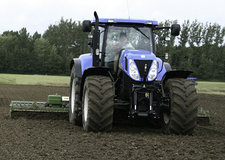The benefits of pasture renovation
 |
Pastures can lose quality as they get older. Although the fields are still covered with grass it is not certain that farmers are still getting maximum output from their pastures. In many modern dairy systems it is crucial to maintain maximum output from the grassland. If not, the fields will produce less dry matter and also the forage quality will become insufficient, resulting in higher (additional) feeding costs per cow. It therefore is important to renovate pastures as soon as they start to lose quality. |
|
When to renovate?
|
|
| Spraying old sward (including product) | 25 |
| Rotary cultivating (5cm) | 100 |
| Ploughing (with land packer) | 113 |
| Levelling out | pm |
| Seedbed preparation & sowing | 90 |
| Seeds | 110 |
| Total costs per hectare | 438 Euro |
| (Costs are based on a Dutch situation) | |
|
After renovation, the improved field offers a better botanical composition of the sward, better sward density and increased dry matter yield and feeding value. What this will mean in economic terms for the farm is presented in the next table.
Yield |
|
| Old sward/ha | kg DM/kg dm | VEM*)/ha | kVEM |
| 60% good grass | 12.000 | 980 | 7.056 |
| 20% weed grass | 8.000 | 790 | 1.264 |
| 10% weeds | 4.000 | 750 | 300 |
| 10% bare soil | 0 | 0 | 0 |
| Yield per hectare | 9.200 | 8.620 | |
| New sward/ha | kg DM/kg dm | VEM/ha | kVEM |
| 90% good grass | 12.000 | 980 | 10.584 |
| 4% weed grass | 8.000 | 790 | 253 |
| 4% weeds | 4.000 | 750 | 120 |
| 2% bare soil | 0 | 0 | 0 |
| Yield per hectare | 11.280 | 10.957 | |
| Difference: | 2.080 | +2.337 |
|
*) VEM= energy value per kg dry matter feed product Fresh grass (normal cut) has an avarage feeding value of 930 930 VEM = 6.7 MjNel
What is the effect of grassland renovation?
Comment |

